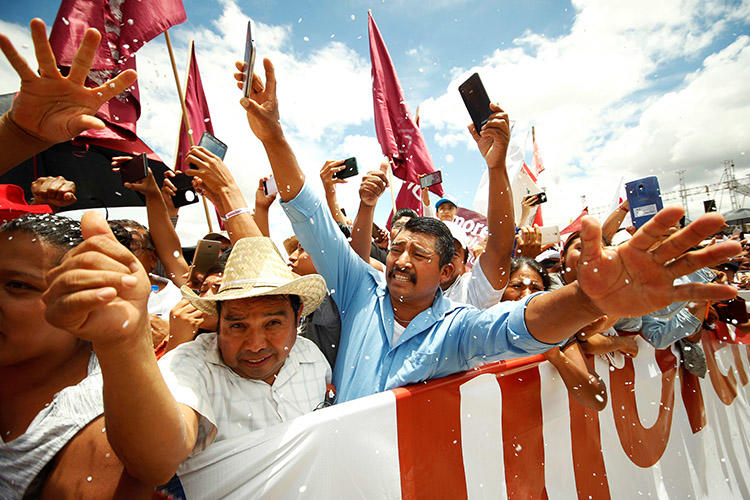On July 1, 2018, Mexico will hold elections for the presidency and congress, as over 3,400 local and state offices in 30 of Mexico’s 32 states are contested. More than 100 candidates and incumbents have been killed during the electoral cycle, according to the privately owned Mexico City-based consultancy company, Etellekt, which is monitoring electoral violence. A June 18 report by Propuesta Cívica, an independent freedom of expression group, logged at least 45 cases of journalists being either verbally abused at rallies, harassed online, or attacked while covering the campaign. Other journalists told CPJ they were denied access to rallies.
Journalists covering election events and rallies in Mexico must take precautions to ensure their safety. Those reporting from high crime areas should observe extra caution, and conduct risk assessments that include contingency planning before traveling to these areas. Device seizures and use of spyware is a risk, so journalists should take digital safety measures to protect their hardware and data.
Additional measures to minimize risk while covering election events and rallies include:
- Plan the assignment and ensure that you have a full battery on your cell phone. Know the area you are going to. Work out in advance what you would do in an emergency.
- Mobile and 3G communication may be poor or completely absent in regions where political rallies are held, as well as during long stretches of the route, especially in rural areas. It is advisable to take a satellite phone when traveling to these regions.
- Always try to work with a colleague and have a regular check-in procedure with your base–particularly when covering rallies or crowd events.
- Wear clothing and footwear that allows you to move swiftly. Avoid loose clothing and lanyards that can be grabbed, as well as any flammable material (i.e. nylon)
- Consider your position. If you can, find an elevated position that might offer greater safety.
- At any location, always plan an evacuation route as well an emergency rendezvous point if you are working with others.
- Maintain situational awareness at all times and limit valuables. Do not leave equipment in vehicles, to avoid break-ins. After dark, the criminal risk increases.
- If working in a crowd, plan a strategy. It is sensible to keep to the outside and avoid getting sucked into the middle where it is harder to escape. Identify an escape route and have a team emergency meeting point.
If dealing with tear gas:
- Wear personal protective equipment including a gas mask, eye protection, body armor and helmet.
- Individuals with asthma or respiratory issues should avoid areas where tear gas is used. Contact lenses are not advisable. If large amounts of tear gas are used, high concentrations of gas may be sitting in areas with no movement of air.
- Take note of potential landmarks (i.e. posts, curbs) that can be used to help navigate out of the area if you are struggling to see.
- If you are exposed to tear gas, try to find higher ground and stand in fresh air to allow the breeze to carry away the gas. Do not rub your eyes or face, which may worsen the situation. When possible, shower in cold water to wash the gas from skin, but do not bathe. Clothing may need to be washed several times to remove the crystals completely, or discarded.
When dealing with aggression:
- Read body language to identify an aggressor and use your own body language to pacify a situation.
- Keep eye contact with an aggressor, use open hand gestures and keep talking in a calm manner.
- Keep an extended arm’s length from the threat. Back away and break away firmly without aggression if held. If cornered and in danger, shout.
- If aggression increases, keep a hand free to protect your head and move with short, deliberate steps to avoid falling. If in a team, stick together and link arms.
- While documenting aggression can sometimes be crucial journalistic work, be aware of the situation and your safety. Taking pictures of aggressive individuals can escalate a situation.
Digital safety:
- Avoid using computers in press offices set up by the government. If you do, avoid logging into personal accounts and clear your browser history.
- Avoid clicking on links or downloading documents in emails, even if the message appears to be from someone you know, or from a government authority. Local journalists have been targeted by spyware sent via SMS messages.
- When covering rallies or crowd events, be aware that equipment may be stolen or seized by the authorities.
- Ensure computers and phones are password protected.
- Remove personal documentation or materials that could put you at risk from your devices. This includes personal photos and documents linked to other stories you are covering.
- Back up all your devices before going out to cover a story.
- Log out of all personal accounts on your computer and phone.
Journalists who are injured or require assistance can contact CPJ via [email protected].
CPJ encourages local and freelance journalists and media organizations to closely follow the safety principles and practices of the ACOS Alliance, which can be found here.
CPJ’s Journalist Security Guide has more information on basic preparedness, assessing and responding to risk, or safety measures when covering civil conflict and disturbances. CPJ’s resource center has additional information and tools for pre-assignment preparation and post-incident assistance.
